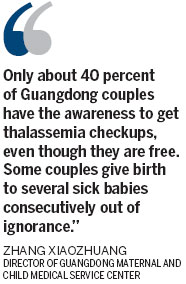
Free checks offered to prevent fatal chronic anemia
With a screening and prevention program that began in 2010, the Guangxi Zhuang autonomous region has prevented the birth of more than 3,000 infants with a lethal form of chronic anemia.
On World Thalassemis Day, Wednesday, the Guangxi Health Department chronicled the successes of its program that screened 2.8 million people and identified 204,400 carriers of the gene that causes the disease.
With 24.5 percent of 51.6 million permanent residents carrying the gene, Guangxi has the highest rate of genetic susceptibility to the disease in China, followed by Hainan and Guangdong provinces with a gene-carrier ratio of about 17 percent.
Over the past three years, the central and Guangxi governments have spent 430 million yuan ($68.25 million) in providing region-wide, free premarital checks and pre-pregnancy screening, the most effective means of controlling the disease.
About 97 percent of Guangxi couples now voluntarily receive the premarital checkups, compared with about 40 percent before the project. The ratio of babies born in Guangxi with thalassemia dropped from 2.06 percent in 2009 to 1.19 percent in 2012.
Similar projects and success rates have been seen in Guangdong and Hainan provinces. Peng Wei, deputy director of Guangdong Health Department, told Nanfang Daily that the province plans in the coming years to match the 35 million yuan spent last year to subsidize the prevention and control of the disease.
The Guangdong Health Department disclosed on Wednesday that 674,000 babies fetuses were screened for the disease in 2012, leading to the prevention 1,805 babies with thalassemia from being born that year. In Guangdong 2.17 percent of infants had thalassemia in 2008. In 2012, the ration dropped to 1.25 percent.
Hainan started providing free pre-pregnancy checkups and screenings for thalassemia for rural couples from this year. So far, 17,864 couples have received the checkups, and 8,188 people were tested for thalassemia genes. More than 40 expecting couples in which both carried thalassemia genes have been identified and properly treated.

But challenges remain. Zhang Xiaozhuang, director of Guangdong maternal and child medical service center, said: "Only about 40 percent of Guangdong couples have the awareness to get thalassemia checkups, even though they are free. Some couples give birth to several sick babies consecutively out of ignorance. So it is necessary for the media to launch a regional publicity campaign to raise people's awareness of the disease. The government should increase its input in constructing grassroots checkup centers and training local medical staff to improve their services to help couples eliminate the chance of delivering sick babies."
Chen Ying, director of family planning service center of Wuzhishan in Hainan, agrees with Zhang. More than 50 percent of the population of some ethnic minority villages in her city carry the thalassemia gene. Chen said: "I strongly recommended that big hospitals in our provincial capital simplify the procedures in poor mountain villages to make it easier for them to receive the free checkups. To my pleasure, the authority followed my suggestion. Now, I think the government should develop grassroots checkup points at hospitals in towns and counties, especially in key areas like ours, to control the disease."
She emphasized that the hometown medical agencies of the migrant workers must take prevention and control of thalassemia seriously because migrant worker couples often do not often go to hospitals in the cities.
Liang Zhicheng, a medical researcher at Jinan University in Guangzhou, said that although there is still a long way to go for China in combating thalassemia, authorities should be confident and can learn from successful experiences in other countries and regions.
Cyprus has prevented any births of babies with thalassemia through effective checkups among a public that is aware of the problem. Thailand, Singapore and Hong Kong have also accumulated valuable experience in this field.
Zhang Xinhua, director of hematology at No 303 Hospital of People's Liberation Army in Nanning , said: "The government's efforts not only help reduce the number of babies born with thalassemia, but also improve the quality of life for some patients. I am happy to see some young thalassemia patients in Guangxi reach their 20s and some even earn their own living after graduating from college."
NGOs and charity organizations also make their contributions to the thalassemia prevention and control projects in Guangxi, Guangdong and Hainan. China Charity Federation initiated a long-term regional project in Guangxi on March 1 to call for care for thalassemia patients and urge the government and hospitals to aid the families to stick to active treatment to help the patients live normal lives.
